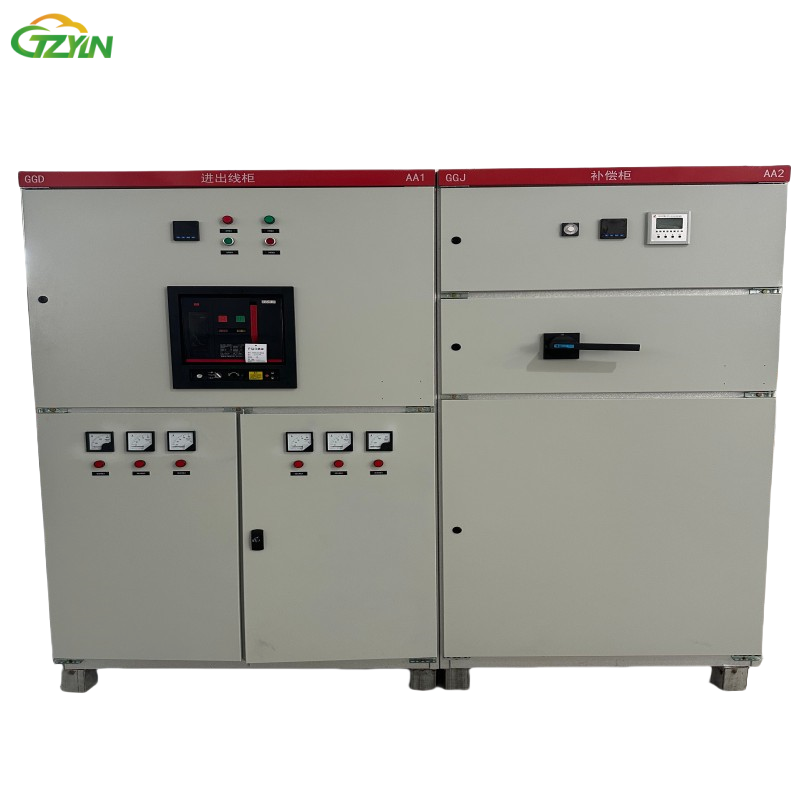Introduction: The Critical Role of Incoming Cabinets
Incoming cabinets play a pivotal role in power distribution systems, serving as the essential gateway for electricity supply management. They are primarily responsible for receiving electrical energy from external sources and distributing it efficiently across networks to ensure a stable power flow. The design and functionality of incoming cabinets are critical as they regulate voltage levels, thereby preventing electrical failures that could disrupt the entire power distribution system. According to studies, inadequacies in incoming cabinet design are often pinpointed as the root cause of electrical outages, further emphasizing their significance in maintaining uninterrupted electricity supply.
Why Incoming Cabinets Are Vital for Power Distribution
Incoming cabinets are integral to the power distribution process, acting as the primary conduits through which electricity is safely introduced and managed from external sources to intricate distribution networks. Their capacity to handle varying voltage levels is vital for maintaining the stability of the entire electrical system. This capability prevents inconsistencies in electricity flow, thereby safeguarding the system from potential failures. Statistics highlight that a majority of electrical disruptions can be traced to poorly designed incoming cabinets, underscoring their importance in preventing outages and ensuring continuous power distribution across networks.
Ensuring Stable and Safe Electrical Supply
The role of incoming cabinets extends beyond power distribution to encompass safety and security within electrical systems. They contribute significantly to reducing the risks associated with electrical fires and equipment damage, safeguarding these systems from catastrophic failures. By efficiently regulating voltage and current, incoming cabinets ensure the stable operation of connected devices, fostering a secure electricity environment. Data from electrical safety boards reveal that systems equipped with well-structured incoming cabinets report fewer incidents of electrical surges, affirming their crucial role in maintaining power security and stability across networks.
Incoming cabinets are not only central to power distribution but also pivotal in offering a reliable and safe operational framework for electrical systems. Their capacity to effectively mitigate potential electrical threats solidifies their place as an indispensable component in modern electricity management strategies.
Key Functions of Incoming Cabinets in Power Distribution
Power Reception and Voltage Regulation
Incoming cabinets play a vital role in power reception, serving as the primary receivers of electricity from various sources, such as transformers and generators. Their design ensures that they can handle power input efficiently from these sources. One crucial function of these cabinets is voltage regulation. By incorporating mechanisms that prevent voltage spikes, they safeguard sensitive equipment from damage. Case studies from leading power companies show that effective voltage regulation not only enhances the safety of systems but also significantly extends the lifespan of electrical appliances by maintaining consistent electrical performance.
Circuit Protection and Fault Isolation
To ensure electrical safety and system reliability, incoming cabinets house essential components such as circuit breakers and fuses, which play pivotal roles in fault isolation. These protective devices automatically disconnect faulty circuits, thereby minimizing the risk of widespread outages that can cause operational disruptions. Technical reports emphasize that incoming cabinets significantly reduce fault recovery time, allowing for swifter resumption of normal operations. Efficient fault isolation within these cabinets is crucial for maintaining Service continuity and protecting investments in electrical infrastructure.
Load Balancing and Energy Efficiency
Load balancing is another critical function of incoming cabinets, facilitating the optimized distribution of electrical power across various circuits. This optimization helps reduce energy wastage and ensure efficient resource usage. Incoming cabinets are designed to support monitoring systems that provide detailed insights into power consumption, which aids in identifying areas for efficiency improvement. Several industry studies have found that facilities that implement effective load balancing strategies save up to 25% on energy costs, underscoring the economic and environmental benefits of optimized power consumption.
Essential Components of Incoming Cabinets
Circuit Breakers and Fuses
Circuit breakers and fuses serve as critical components in protecting electrical circuits from overloads and short circuits. These devices not only safeguard vital equipment but also enhance the overall reliability of the power distribution system. By immediately interrupting electrical flows when faults occur, they prevent potential damage and hazards. Regular maintenance of these components is essential; data shows that it can reduce system downtime by over 30%, ensuring the smooth operation of facilities and mitigating risks associated with electrical failures.
Surge Protection Devices (SPDs)
Surge Protection Devices (SPDs) are essential in safeguarding equipment from over-voltage transients, which can occur due to events like lightning strikes or power switching anomalies. Incorporating SPDs into incoming cabinets is crucial for shielding sensitive electronics from damage, thereby prolonging their operational life. Studies illustrate that installations equipped with SPDs experience markedly lower rates of equipment failure, underscoring their role in enhancing the resilience of power infrastructures. This preventive measure is vital for ensuring continuous and reliable operation across industrial and commercial environments.
Monitoring and Control Systems
Advanced monitoring and control systems are integral to incoming cabinets, providing real-time data that facilitates proactive power management. These systems enable automation that optimizes power usage and improves overall operational efficiency. By delivering insights into power distribution patterns, they allow for swift identification and rectification of anomalies, thereby preventing potential disruptions. Research indicates that facilities equipped with these monitoring systems witness significant improvements in response times to electrical issues, ultimately leading to enhanced performance and safety.
Safety and Reliability: Protecting Power Systems
Overload and Short-Circuit Protection Mechanisms
Incoming cabinets are meticulously designed with mechanisms to detect and mitigate overloads and short circuits. These vital features play a crucial role in maintaining the safety and reliability of electrical power systems. Overloads and short circuits can cause significant damage, leading to expensive repairs and prolonged downtime. Thus, the integration of such mechanisms in the design ensures that electrical systems operate safely and efficiently. Safety boards globally advocate for regular inspections and testing of these mechanisms, ensuring they function optimally at all times to provide uninterrupted protection.
Grounding Systems and Surge Suppression
Effective grounding systems are indispensable in preventing electrical shocks and safeguarding equipment against damage. These systems ensure that any electrical fault is swiftly directed to the ground, minimizing the risk of equipment damage and personal injury. Additionally, surge suppression devices integrated into incoming cabinets act as a buffer against power surges, which can arise from lightning strikes or faulty equipment. Regulatory standards emphasize the importance of compliant grounding systems and surge suppression in any electrical setup. Adhering to these standards not only helps in safeguarding infrastructure but also enhances the overall reliability and safety of power systems.
Types of Incoming Cabinets for Different Applications
Low-Voltage vs. High-Voltage Configurations
Understanding the difference between low-voltage and high-voltage incoming cabinets is crucial for selecting the right type for specific applications. Low-voltage cabinets, typically used in residential and commercial settings, are designed to handle voltages up to 1,000 volts. They feature specific design elements that prioritize ease of use and safety in these environments. In contrast, high-voltage cabinets, which can manage voltages above 1,000 volts, are often found in industrial or utility sectors. These cabinets are built to withstand harsh conditions and ensure safety under significant electrical loads. According to industry benchmarks, choosing the appropriate voltage configuration not only enhances system efficiency but also ensures a high level of safety. This is essential in preventing electrical failures and maintaining stable power distribution.
Modular Designs for Industrial Flexibility
Modular incoming cabinet designs provide unparalleled flexibility for industrial applications, particularly for businesses requiring rapid operations scaling. Such designs allow easy integration of new components and seamless system upgrades, which reflect the dynamic demand of industrial settings. As industrial demand evolves, these systems can be quickly adapted, thereby supporting continual business growth without excessive costs or delays. Recent market trends show that adopting modular systems can significantly reduce project completion times, mitigate downtime, and lower operational costs. This adaptability is a crucial competitive edge, especially in fast-paced and continuously developing industrial environments.
Conclusion: Why Investing in High-Quality Incoming Cabinets is Crucial for Power Security
Investing in high-quality incoming cabinets plays a vital role in ensuring power security. These cabinets serve as the first line of defense against electrical failures and provide stability in power distribution systems. They are designed to withstand harsh conditions and safety threats, which makes them integral in maintaining uninterrupted power supply and avoiding potential hazards. High-quality cabinets enhance system efficiency, contribute to reliable operations, and thus prove to be a wise investment for any facility aiming at uninterrupted power flow and safety.
FAQ
What are incoming cabinets used for?
Incoming cabinets are used for receiving electrical energy from external sources and distributing it efficiently across networks, ensuring stable power flow and voltage regulation.
Why is voltage regulation important in incoming cabinets?
Voltage regulation is important as it prevents voltage spikes, safeguarding sensitive equipment from damage and ensuring consistent electrical performance.
How do incoming cabinets contribute to safety?
They incorporate circuit breakers and fuses for fault isolation, surge protection devices for over-voltage transients, and grounding systems to prevent shocks, enhancing overall safety.
What are the differences between low-voltage and high-voltage configurations?
Low-voltage cabinets handle up to 1,000 volts for residential/commercial use, while high-voltage cabinets manage above 1,000 volts for industrial/utility sectors, ensuring safety under significant loads.




